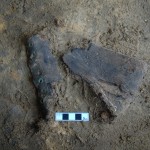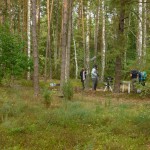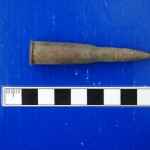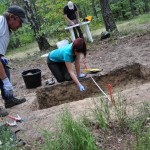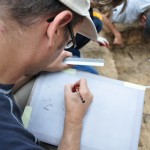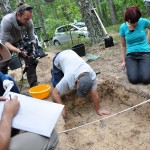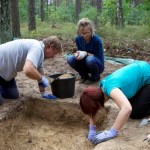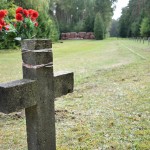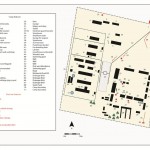Labour Camp (Treblinka I)
- Our research has identified previously unknown survivors from Treblinka I and interviews have taken place to record their experiences during their internment.
- Archaeological field and geophysical survey, aerial photographic analysis and LiDAR interpretation have identified close to 100 structures and features associated with the site dating to both the camp’s period of occupation and post-war activity. Numerous features were previously unknown.
- The remains of many of the camp buildings not visible above the ground were shown to exist below the ground.
- This work has been used to create a revised camp plan and will help assist in the installation of new information boards that are correctly positioned around the site.
- This work has been used to help formulate a conservation plan for the existing concrete structures (barrack and building foundations and floor surfaces) across the site to preserve these features.
Execution Site
- LiDAR analysis suggested that several previously unknown mass graves may exist in this area.
- It was not possible to carry out a geophysical survey in these areas due to the density of woodland.
- Targeted excavations of the sites identified through LiDAR analysis confirmed the presence of previously unmarked mass graves close to the execution site of Treblinka I.
- These excavations were minimally invasive to allow minimal disturbance to the remains. These graves can now be marked and the victims commemorated.
- Further areas containing potential graves will be investigated in future fieldwork.
- Leather shoe fragments from execution site test pit
- Excavating one of the previously unknown mass grave at the execution site at Treblinka I
- Bullet cartridge recovered from one of the test pits
- Excavating one of the previously unknown mass grave at the execution site at Treblinka I
- Recording the evidence
- Sieving the sandy soil to recover the smallest of artefacts
- Excavating one of the previously unknown mass grave at the execution site at Treblinka I
- Excavating one of the previously unknown mass grave at the execution site at Treblinka I
- Memorial at the execution site at Treblinka I
- New plan of Treblinka I forced labour camp after fieldwork and aerial imagery assessment
Read about the results of the survey of the extermination camp at Treblinka II.
The Finding Treblinka project was documented as part of a Channel 5 television programme, Treblinka: Inside Hitler’s Secret Death Camp, (produced by Furneaux and Edgar Productions) which was aired in November 2013 in the UK and March 2014 in the USA.
The work at Treblinka is ongoing. The team have since returned to Treblinka several times. More information regarding the fieldwork and research at Treblinka can be found by visiting the links below and through Professor Caroline Sturdy Colls’ publication page. Fieldwork carried out in 2017 as part of the HERA funded iC-ACCESS project, included continued excavations at the site of the gas chambers and of the camp waste pits, as well as an extensive photogrammetric survey. The use of 3D technologies at Treblinka is further discussed in Dr Dante Abate and Professor Caroline Sturdy Colls’ paper ‘A multi-level and multi-sensor documentation approach of the Treblinka extermination and labor camps’ available on Science Direct.
The full results of the research are published in various journal articles and in Sturdy Colls, C. (In Prep.) Finding Treblinka. Archaeological Investigations at Treblinka Extermination and Labour Camps [In English and Polish] in 2014.
Some of the publications pertaining to the work carried out at Treblinka include the following:
Sturdy Colls, C. 2015. Finding Treblinka: An Exhibition of Forensic Archaeological Research. Exhibition Catalogue. Stoke-on-Trent: Staffordshire University.
Sturdy Colls, C. and Branthwaite, M. 2017. ‘This is proof”? Forensic evidence and ambiguous material culture at Treblinka extermination camp’. International Journal of Historical Archaeology 23. DOI 10.1007/s10761-017-0432-3. View article
Sturdy Colls, C. 2015. Mapping Nazi Terror: Archaeological Investigations at Treblinka Extermination and Labour Camps. Proceedings of the Archaeology of Violence: Archaeology of War, Archaeology of Mass Violence Conference, France. [In French] Sturdy Colls, C. 2016. Une cartographie de la terreur nazie : études archéologiques dans les camps de travail et d’extermination de Treblinka. In: Guilaine, J. and Semelin, J. Violences de guerre, violences de masse. Une approche archéologique. Paris: Le Decouverte.
Sturdy Colls, C. 2014. ‘Gone but not forgotten: Archaeological approaches to the landscape of the former extermination camp at Treblinka, Poland’, Holocaust Studies and Materials 3. Available as an e-book Gone but not forgotten.
Sturdy Colls, C. 2012. O tym, co minelo, lecz nie zostalo zapomniane. Badania archeologiczne na terenie bylego obozu zaglady w Treblince. Zaglada Zydow. Studia i Materialy 8 (in Polish), 77-112. For more information see: http://www.zagladazydow.org/?l=a&lang=pl
To learn more about Professor Caroline Sturdy Colls and the work she has carried out, visit her profile page.

